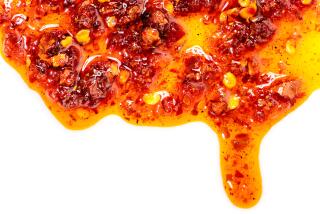An inviting herbal accent
THAT beautiful leaf, artfully placed under your toro (tuna belly) sashimi, isn’t just the Japanese equivalent of an old-school sprig of parsley. It’s a captivating herb that’s sort of cinnamon-y, sort of basil-ish, kind of anise-like. You might catch a note of cumin or curry leaf, along with a hint of citrus.
That leaf is shiso, called by a host of other names as well. Akashiso is the common Japanese name for red or purple-leafed shiso, aoshiso is the green-leafed variety -- at a sushi bar, it might be called ohba. In North America, it’s known primarily as perilla, but also as beefsteak plant and summer coleus. All parts of the plant -- leaves, flowers, roots, seeds and stems -- are used in a variety of Asian dishes.
Think of shiso as a chic and exotic cousin to basil and mint, and try it anywhere you’d use either. Its leaves are somewhat fragile, like basil, and it doesn’t keep for long. And like basil, add it at the end of cooking, or even after a dish is removed from heat to preserve its aroma and flavor. It’s widely available in Asian markets (though, depending on which Asian market you frequent, you may have to remember one of its other names -- its Chinese name is bai su; in India, salim; tia to in Vietnamese; and kkaennip in Korean), often packaged in pretty little stacks of leaves, with a string or rubber band wrapped around the stems.
Shiso’s a natural with tuna, adding a fragrant green note to an easy sandwich of salty capers, meaty Italian tuna and sweet tomatoes. In Korean cuisine, it’s often served with a roasted tidbit of pork belly, smeared with spicy chile-garlic sauce and wrapped in a leaf. Or seasoned with a simple marinade of soy sauce, a splash of sesame oil, scallions, garlic, chile flakes and a bit of brown sugar -- the leaves bathed in sauce then arranged in neat stacks, and eaten as a salad. Korean and Japanese cooks alike take advantage of the leaf’s beauty by frying it in tempura batter.
Shiso pairs beautifully with fruit, as when slivers of it top juicy broiled citrus. Or try simply cutting chunks of seasonal fruit -- think peaches, berries, cherries, even melons -- then splash with sweet white wine and a chiffonade of shiso, and let it sit until you’re ready for dessert.
You could do an East-meets-West riff on sangria with any leftovers. Add them, with more fruit and whole shiso leaves to a bottle of good prosecco. Serve it with sushi or tapas, or both.
At Mako in Beverly Hills, chef Makoto Tanaka likes shiso in a plum vinaigrette, which he drizzles over tomatoes and white asparagus. He also adds the chopped leaves to wakame seaweed salad. Chef Nobu Matsuhisa, of Matsuhisa and Nobu, takes shiso luxe by wrapping a leaf around succulent shrimp with a shiitake mushroom, grilling, then topping with caviar.
Toss shiso and watercress leaves with sliced radishes, or grated daikon, and dress with lemon juice and a few drops of sesame oil. And to really groove your fashionable cousin vibe, sprinkle black and white sesame seeds on top.
When you don’t feel like turning on the stove, nestle shiso leaves inside softened rice paper wrappers, add diced nectarine or mango, a few shrimp and some crushed peanuts, then roll them up and eat them from a chilled plate, while you sip icy green sun tea that you’ve steeped with a handful of shiso leaves. You’ll feel like you’re the chic and cool cousin.
More to Read
Sign up for our L.A. Times Plants newsletter
At the start of each month, get a roundup of upcoming plant-related activities and events in Southern California, along with links to tips and articles you may have missed.
You may occasionally receive promotional content from the Los Angeles Times.






